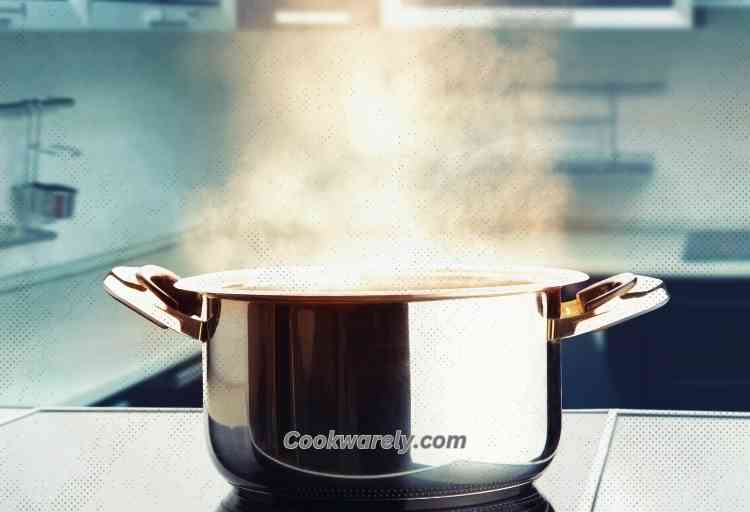How to Clean a Dutch Oven: Care and Maintenance Guide
Dutch ovens, prized for their versatility and durability, are essential kitchen tools. Whether you own a classic cast iron Dutch oven or the enameled variety, proper cleaning is crucial to maintain their performance and longevity.
Cleaning a Dutch oven involves different methods depending on its type.
For cast iron Dutch ovens, daily wiping and occasional boiling with scrubbing are key. Enameled Dutch ovens require soaking with baking soda and gentle scrubbing.
Regular maintenance ensures longevity.
3 Steps to Clean a Dutch Oven
| Steps | Cast Iron Dutch Oven | Enameled Dutch Oven |
|---|---|---|
| 1. Daily Maintenance | – Wipe down with a dry paper towel after use. | – Allow it to cool after use. |
| – Use a moist paper towel for sticky residue. | ||
| 2. Removing Burned-On Food | – Boil water to cover burned-on food, cool, | – Fill with hot water, dish soap, and 2 tbsp |
| and scrub. | of baking soda. | |
| – Rinse thoroughly. | – Let it sit for 15 minutes. | |
| – Dry completely (heat on the stove if needed). | – Scrub with a non-abrasive sponge. | |
| – Apply a thin layer of cooking oil and wipe | – For stubborn stains, use baking soda paste | |
| away excess. | overnight. | |
| 3. Final Steps | – Scrub again and rinse thoroughly. | |
| – Dry on a rack or with a dish towel. |

How to Clean a Dutch Oven?
To keep your cast iron Dutch oven in prime condition, adopt these daily cleaning practices:
- Wipe Down After Each Use: After cooking, use a dry paper towel to wipe down the interior of the Dutch oven. This removes any residual food particles and prevents them from sticking.
- Dealing with Sticky Residue: If you encounter sticky residue, use a moist paper towel to gently wipe it away. Ensure that the Dutch oven is completely dry afterward to prevent rusting.
Removing Burned-On Food
For stubborn, burned-on food residue, follow these steps:
- Boil Water Method: Fill the Dutch oven with enough water to cover the burned-on food residue. Bring it to a boil on the stove and let it simmer for a few minutes. This will loosen the stubborn bits.
- Scrubbing: Once the Dutch oven has cooled to a safe temperature, use a brush scrubber or a chainmail scrubber designed for cast iron. Scrub the interior until the residue is gone.
Final Steps
After removing the food residue, complete the cleaning process:
- Thorough Rinsing: Rinse the Dutch oven thoroughly with warm water to remove any remaining soap or food particles.
- Proper Drying: Dry the Dutch oven completely. You can place it back on the stove over low heat for about 20 minutes to ensure it’s completely dry.
- Seasoning: To maintain the seasoning of your cast iron Dutch oven, apply a small amount of cooking oil to the interior. Use a paper towel to spread the oil evenly, then wipe away any excess oil. This prevents rust and maintains the non-stick surface.
Cleaning an Enameled Cast Iron Dutch Oven
Post-Use Cooling
Properly cleaning an enameled cast iron Dutch oven starts with these steps:
- Allow Cooling: After use, allow the enameled Dutch oven to cool to room temperature. This prevents thermal shock, which can damage the enamel coating.
Soaking with Baking Soda and Dish Soap
For regular cleaning, use this method:
- Hot Water and Soap: Fill the enameled Dutch oven with hot water and a small amount of dish soap. Add two tablespoons of baking soda. Let the mixture sit for about 15 minutes to loosen any food residue.
- Scrubbing: Pour out the soapy water and use a non-abrasive dish scrubber or sponge to gently remove any remaining residue. Rinse thoroughly.
Tackling Stubborn Stains
For persistent stains, try this approach:
- Baking Soda Paste: Create a paste by mixing three parts baking soda with one part water. Apply this paste to the stubborn stains and leave it overnight.
- Morning Scrub: In the morning, scrub the stained areas with a dish scrubber, dish soap, and hot water.
Final Washing and Drying
Finish the cleaning process with these steps:
- Final Wash: Give the enameled Dutch oven a final wash with dish soap and warm water, ensuring all cleaning agents are thoroughly rinsed away.
- Drying: Dry the Dutch oven on a drying rack or with a dish towel. Proper drying prevents moisture-related issues and maintains the enamel finish.
General Dutch Oven Care Tips
Avoiding High Heat Settings
While Dutch ovens are known for their heat retention, using excessively high heat settings can lead to stains and damage to the enamel. It’s best to cook on low to medium heat for most recipes.
Hand Washing vs. Dishwasher
Avoid using the dishwasher to clean your Dutch oven, as the harsh detergents and high temperatures can dull the enamel finish. Hand washing with gentle dish soap is the preferred method.
Additional Stain-Removal Methods
For tough stains, consider these alternative methods:
- White Vinegar and Water: Soak the Dutch oven in a mixture of white vinegar and water. This can help remove stains caused by acidic foods.
- Bar Keepers Friend Cleanser: This non-abrasive cleanser is effective at removing stains without damaging the enamel.
- Bleach Solution: For light-colored enamel interiors, a 50/50 mixture of water and bleach can be used to combat stubborn stains. Ensure thorough rinsing after using bleach.
Avoiding Abrasive Cleaning Materials
Never use abrasive materials like steel wool or metal brushes to clean your Dutch oven. These can scratch the enamel or remove the seasoning from cast iron, compromising their performance.
Preventing Cracking due to Temperature Changes
Allow your Dutch oven to acclimate to temperature changes gradually. Avoid placing a hot Dutch oven on a cold surface or exposing it to sudden temperature extremes, as this can cause cracking.
Ensuring Longevity
Understanding what constitutes normal wear and tear for your Dutch oven is essential. Stains, dulled enamel, and light marks are part of the natural aging process and don’t affect performance.
However, if you notice enamel chips or peeling, it’s time to consider replacing your Dutch oven.
Always check the manufacturer’s warranty for coverage, as some defects may be covered for a specific period.
Regular cleaning and maintenance, as outlined in this guide, can help ensure the longevity of your Dutch oven, allowing it to withstand high temperatures and serve you well for years to come.
Conclusion
Finally, cleaning and maintaining a Dutch oven involves a combination of daily care, effective stain removal methods, avoiding damaging practices, and proper maintenance to ensure its longevity.
With the right approach, your Dutch oven can remain a reliable kitchen companion for many meals to come.




